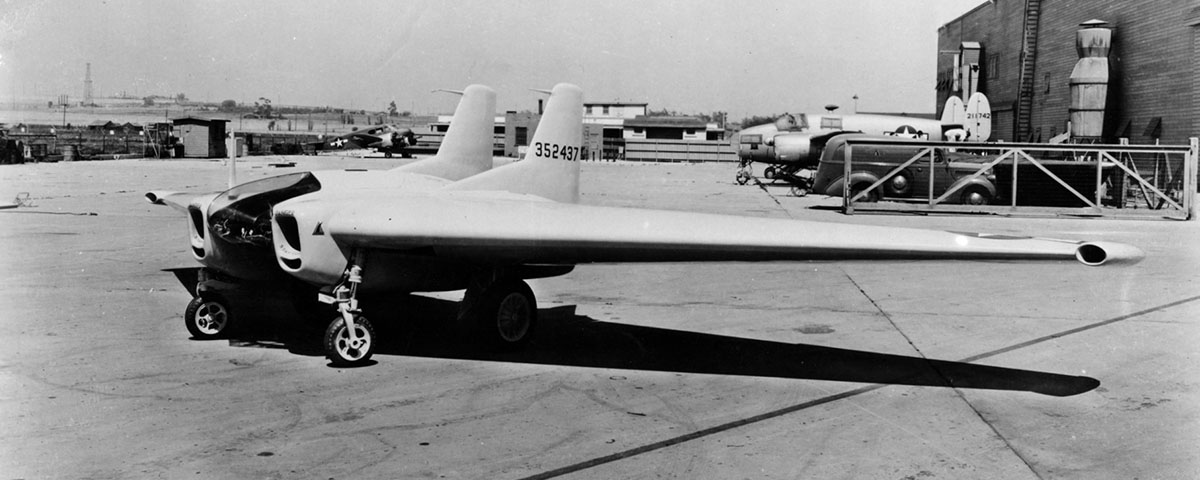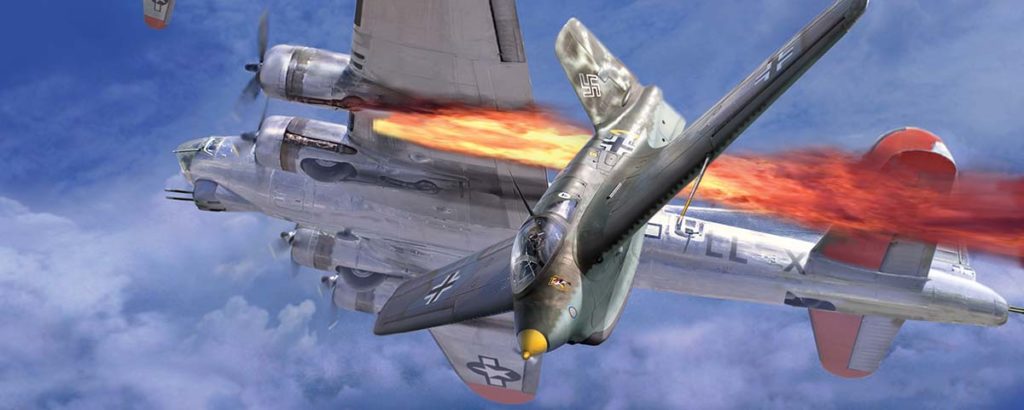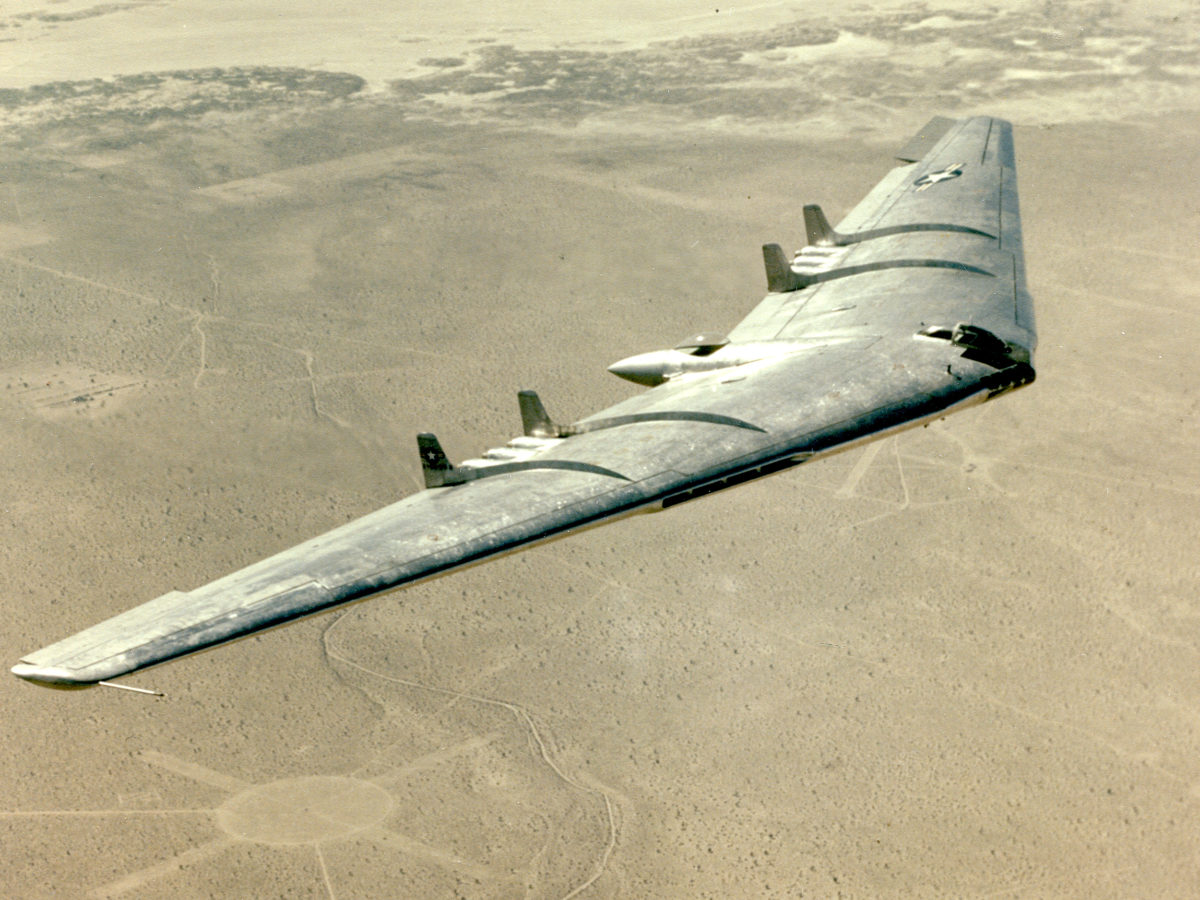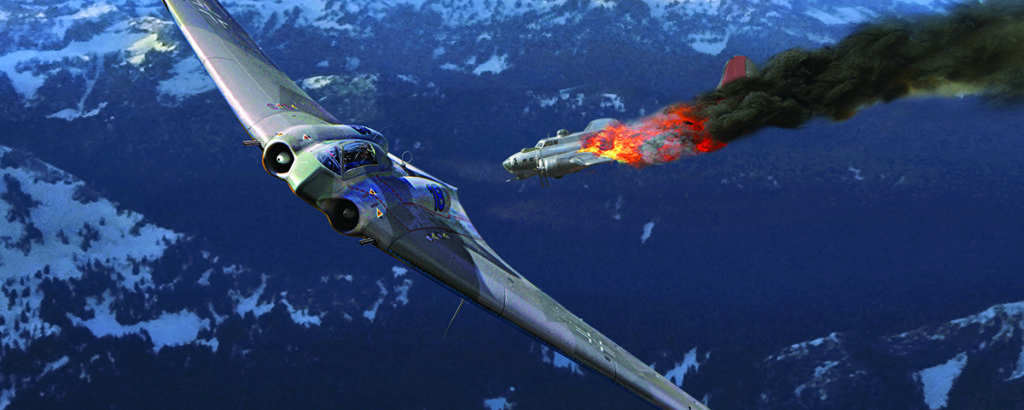In the late stages of World War II, American bomber formations over Germany were occasionally attacked by a small, rocket-powered interceptor, the Messerschmitt Me-163 Komet. Fast as the Me-163s were, however, they were usually more spectacular than effective. Nevertheless, American aircrews must have marveled at the technology behind such an advanced-looking weapon–unaware that since 1942, something similar had been secretly under development in their own country.
The fighter that eventually became the Northrop XP-79B had an astonishing parallel development to the Me-163. It began in 1942 as a rocket-powered flying wing, but, in contrast to the Me-163, the American design was later adapted for jet power. Another difference between the XP-79B and its distant German cousin lay in their methods of attack. The Me-163 was meant to defend a faltering Third Reich with wing-mounted 30mm cannons or unguided rockets. The XP-79B’s main means of downing its adversaries is best expressed in its nickname–Flying Ram.
John K. (“Jack”) Northrop designed numerous advanced aircraft of conventional configuration, but he was fascinated by the flying-wing concept. He believed that such a pure airfoil surface would have the most efficient lifting capabilities. Also, the absence of a fuselage and tail unit would mean less drag to affect overall performance–as well as lower production costs. Shortly after designing Lockheed’s famed Vega series of monoplanes, Northrop formed a small company of his own, the Avion Corporation in Burbank, Calif. His first Flying Wing made a successful maiden flight from Burbank Airport in 1929. It was originally powered by a single tractor-mounted engine, and tail surfaces mounted on twin booms aft of the wing increased controllability. Northrop’s creation was modified to pusher-engine configuration before undergoing further flight testing at Muroc Dry Lake, Calif. Avion was renamed the Northrop Aircraft Corporation that same year and became part of United Aircraft and Transport Corporation, an early super-conglomerate that also included Boeing.
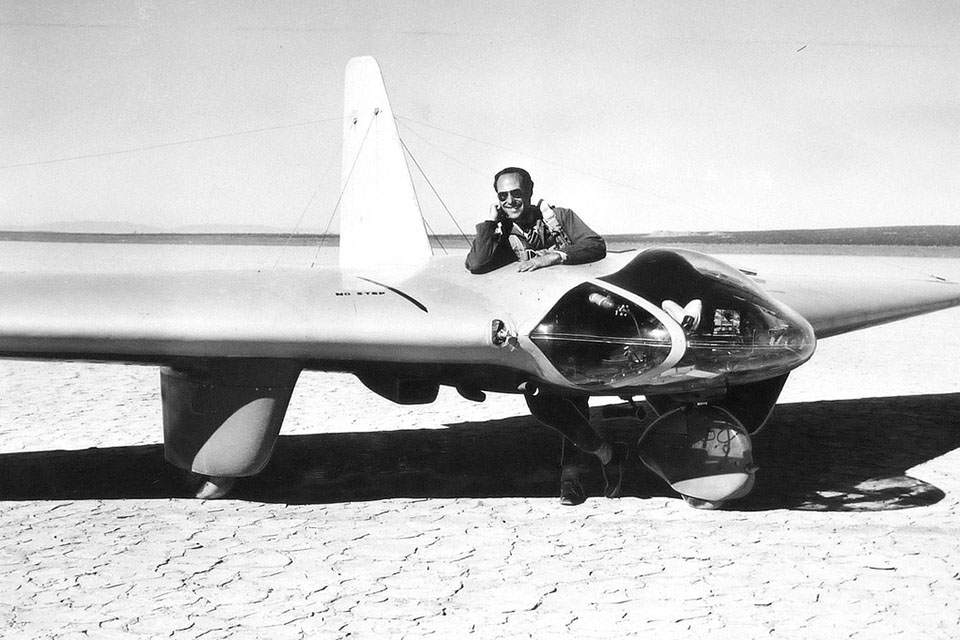
During the Great Depression of the 1930s, Northrop temporarily shelved his flying-wing dream to create some solid moneymakers, like the record-breaking Alpha, Beta, Gamma and Delta series of high-speed mail planes, and military designs such as the BT-1 and A-17. Then in 1939, Northrop broke away from United to form a completely independent firm, Northrop Aircraft Inc., and relocated to Hawthorne, Calif. He obtained subcontracts to manufacture other companies’ aircraft before gaining his first new contract for a design of his own–an order from Norway for 24 N-3PB seaplane patrol bombers.
Northrop felt confident enough to resume his flying-wing experiments in 1940. His next attempt, the N-1M, was the genuine article, dispensing with the boom-mounted tailplanes. It first took to the air on July 3 with Vance Breese at the controls. Breese reported that the N-1M handled well and seemed to require less horsepower than a conventional aircraft to achieve the performance he wrung out of it. The N-1M originally was powered by twin 65-hp Lycoming engines driving pusher propellers, but it underwent several changes in power plant and wingtip configuration in the course of more than 200 flights. Fortunately, the historic N-1M was preserved, and it is now on display at the National Air and Space Museum.
Northrop continued to experiment with flying wings like the N-9M and JB-1 during World War II. He also produced a fighter, the XP-56 Black Bullet. This was a pusher-engine canard design that was almost all wing. (There was a tailless fuselage of sorts, from which dorsal and ventral vertical control surfaces protruded.) The XP-56 proved to be a failure, but that was compensated for by the brilliant success of Northrop’s more conventional twin-engine, twin-boom night fighter, the P-61 Black Widow.
Northrop’s flying-wing concept took a dramatic step forward in 1942, when he convinced the U.S. Army Air Forces (USAAF) that he could build a fighter that could reach the speed of sound. Beneath the USAAF-classified wraps, “Project 12,” as the design was designated, was a rocket-powered flying wing with a wingspan of only 32 feet. The pilot was to fly it in a prone position, the rationale being that such a posture would make him less vulnerable to G-forces and raise his “blackout threshold” beyond normal human limits.
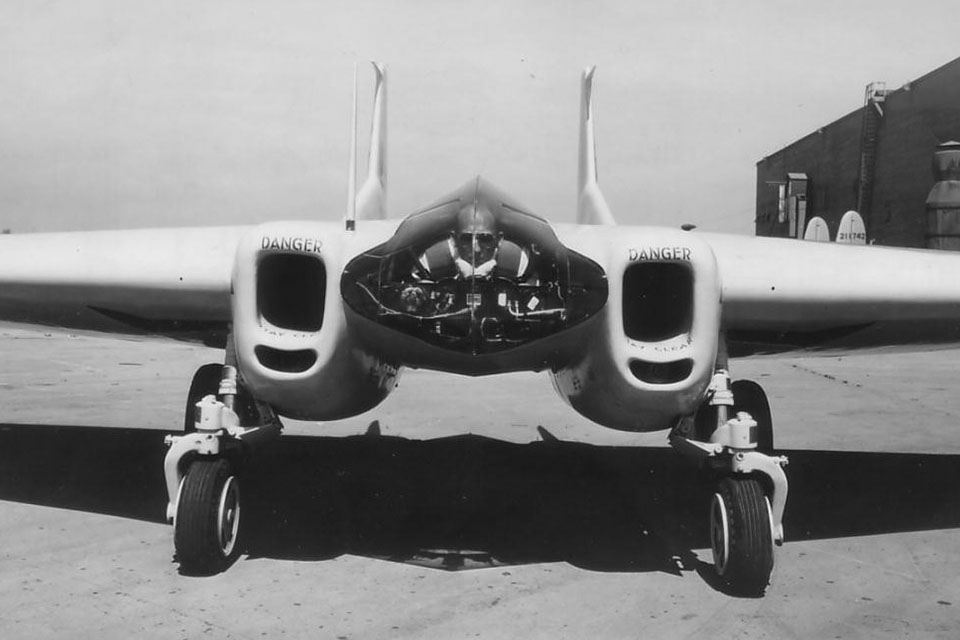
The first experimental vehicle under Project 12 was the MX-324, a glider that was to be followed by a powered version called the MX-334. A simple steel tube and wood affair with faired, fixed landing gear, the MX-324 had a wire-braced vertical fin that looked as if it had been added as an afterthought–which, in fact, it had been, since it could be and later was removed. In one of the most undignified methods ever devised for getting into an airplane, the pilot had to clamber up on the trailing edge of the wing and slither on his stomach through a triangular hatch. After some unsuccessful attempts to use an automobile to tow the MX-324 skyward, it was towed into the air behind a Lockheed P-38 Lightning.
During an early flight, the MX-324’s test pilot, prewar racing pilot Harry Crosby, encountered trouble when turbulence behind the P-38 towplane flipped the glider upside down. The MX-324 went into a spin. Even when it suddenly came out of the spin, it was still inverted and descending in ever-tightening circles.
More Flying Wings
Crosby jettisoned the two-part hatch-canopy, climbed out on the wing and kicked free. After his parachute opened, however, he saw the runaway glider coming right at him. As luck would have it, the wayward wing narrowly missed Crosby and came down in the desert a short distance from where he came to earth. Little could Crosby have suspected that he would find himself in a similar situation in a similar airplane two years later…with a far less happy landing.
The MX-334 took to the air in October 1943 for some unpowered testing while the Aerojet Corporation completed its XCAL-200 rocket engine, which was to be powered by monoethyaniline fuel, oxidized by red fuming nitric acid. The MX-334 made its first flight with the new engine on June 23, 1944, and fulfilled Northrop’s promise to the USAAF. Although capable of only 3.5 minutes of powered flight, it was the first American rocket-powered aircraft to fly.
Despite the effort put into the secret project, the USAAF ultimately concluded that the rocket-powered MX-334 was a dead end. Much research data had been culled from it, however, and Northrop had a spinoff of Project 12 in the offing that the USAAF regarded as being militarily far more feasible–the XP-79.
Essentially, the XP-79 was an interceptor that would bring down its opponents by ramming them in flight. During the early months of the German invasion of Russia in 1941 and 1942, Russian fighter pilots had frequently resorted to various taran, or midair ramming techniques. There was no real need for American fighter pilots to resort to such tactics, however, and the USAAF officer who came up with the idea for the ram fighter may be grateful that his identity is lost to history. In any case, in January 1943, Northrop was awarded a contract to build three XP-79 Flying Ram prototypes, each of which was to be powered by an Aerojet rocket engine with 2,000 pounds of thrust.
A plague of developmental problems with the proposed Aerojet engine, and the unlikelihood of its being able to keep the plane airborne for more than 30 minutes, led the USAAF to cancel its order for the rockets and for two of the XP-79s that were to be powered by them. The Army did, however, consent to completion of the third prototype, which used two Westinghouse 19B axial-flow jet engines with 1,345 pounds of thrust each. The jet-engine revision, designated the XP-79B, weighed 5,840 pounds empty and 8,669 pounds with a full operational load.
Like its rocket-powered precursor, the jet-powered XP-79B was essentially a wing, with the pilot lying on his stomach between the two jet engines. His head protruded into an acrylic-plastic windshield fitted with an armor glass section. An overhead hatch gave him entry to and, if necessary, a hasty exit from the cabin.
As radical as the XP-79’s all-wing configuration looked, its structure was equally unusual. The airframe was made of heavy-gauge magnesium. The leading-edge skin was three-fourths of an inch thick; reinforcing steel armor plate of one-fourth-inch thickness was heliarc-welded at a 45-degree angle just inside the wing’s leading edge. The wingspan was 38 feet, with a wing area of 278 square feet. Overall, the XP-79 was 14 feet long and 7 feet high.
Upon receiving reports of approaching enemy bombers, the XP-79B was intended to take off with the aid of JATO (jet-assisted takeoff) packs at an estimated rate of 25,000 feet in 4.7 minutes. Reaching an altitude of 40,000 feet, the Flying Ram would then dive into the formation of enemy aircraft at an estimated speed of up to 547 mph and clip their wing or tail surfaces with its own reinforced wings. Even among the USAAF brass, someone must have recognized the absurdity of that idea, because the XP-79B order also stipulated that the fighter should accommodate four .50-caliber Browning machine guns outboard of the jet engines. Neither the guns nor the cockpit pressurization system (allowing the pilot to function at 40,000 feet) were destined to be installed in the plane.
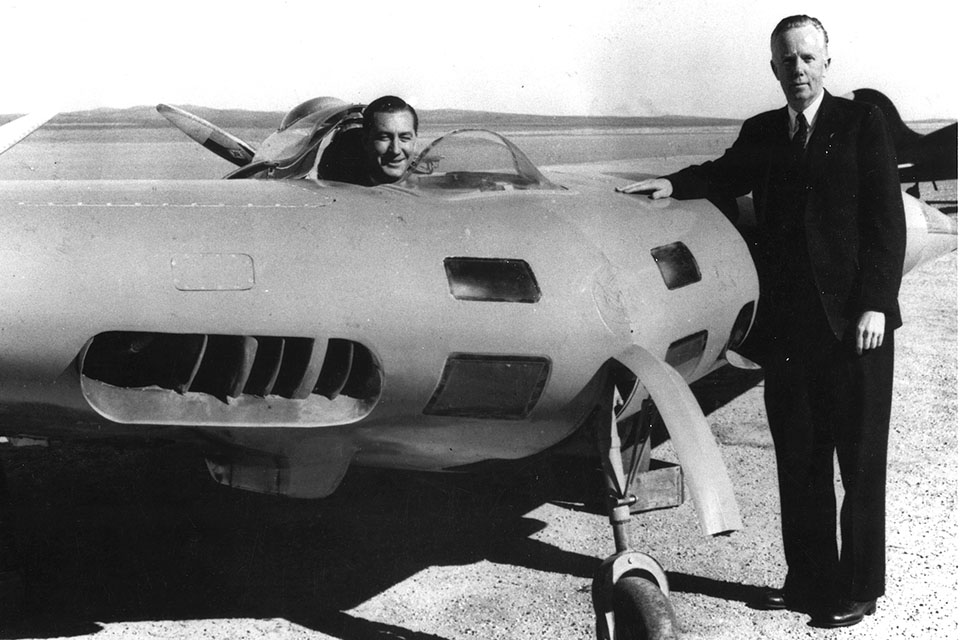
Painted white overall, and given the serial number 43-32437, the prototype XP-79B was covered with canvas and trucked to the Muroc Dry Lake testing facility. Its first taxiing tests were conducted in June 1945–during which its tires burst on several occasions.
Finally, on September 12, 1945, Harry Crosby prepared to take the XP-79B up for its maiden flight–and almost ran into disaster before he got off the ground. As the plane accelerated down the runway, an Army firetruck pulled out directly in its path. Crosby chopped the throttle but then applied power again as the truck got out of his way.
Taking off without further incident, Crosby climbed to 10,000 feet. During the next 15 minutes, he flew back and forth over the field, testing the exotic plane’s ability to turn. Things suddenly went wrong during one such turn, and degenerated into a nose-down spin. After a brave but futile effort, Crosby finally judged it impossible to regain control of the plane. Jettisoning the escape hatch, he tried to leap clear–only to be struck by the wildly gyrating wing. Crosby fell to his death, his parachute unopened. The XP-79B slammed into the desert floor and exploded in a white-hot flare of magnesium that consumed the entire plane.
Northrop’s engineers determined that the control problem that had cost Harry Crosby his life could be corrected, but the USAAF decided to abandon the XP-79B project. World War II was over, the Lockheed P-80 Shooting Star was entering production, and other, more conventional jet designs were showing greater promise than the flying-ram concept.
The techniques involved in the production of the XP-79B would later help in the development and mass production of the ultimate realization of Jack Northrop’s flying-wing dream–his giant B-35 and B-49 bombers. Judged on its own merits as a fighter, however, the Flying Ram was a preposterous idea from the outset–a waste of time, money and effort, as well as the life of one of America’s finest test pilots.
This article was written by Jon Guttman and originally published in the January 1996 issue of Aviation History Magazine. For more great articles subscribe to Aviation History Magazine today!

